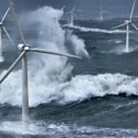Offshore wind – the new frontier
Denne artikkelen er over ti år gammel og kan inneholde utdatert informasjon.

Av Tyson Weaver
In light of the EU2020 carbon reduction directive EU member states have scurried to discover and implement scalable solutions that enable these targets to be met. It can be said that wind energy has been the clear market winner in light of the fact 70 gigawatts (GW) of capacity has been installed in the EU since the ’97 White Paper was published. Given the high population density per capita within the EU there would inevitably be a technical limit to deploying more wind power. Or would there?
The Danes pioneered the activity 20 years ago however the initial commercialization really occurred within the past decade. Future plans of deployment in the UK and Germany are extremely ambitious. The UK is currently the market leader and intends to remain so with their leasing of sea bed space capable of installing 33GW in total. The European Wind Energy Association anticipates 40GW will be installed by 2020. Currently there is only 2,9 GW installed.
The cost to deploy offshore wind energy has nearly tripled in 10 years, yet project development activity is busier than ever. How can this be explained? Can we assume that project developers are making money hand over fist so the absence of cost control need not hinder their plans?
The common industry argument justifying higher costs for offshore wind as opposed to onshore is the higher wind speeds and more annual load hours overly compensate for increased costs. Yet offshore wind energy players heavily rely on subsidy support mechanisms to ensure profitability. Interestingly enough little is known within the academic fields about the interworking of project economics for offshore wind energy production. Many existing studies only focus either on the expenditure components or the subsidy frameworks that provide income support.
For this reason I chose to incorporate both income and expenditures to investigate the financial merits of deploying offshore wind energy. Clearly profitability of energy projects is site specific, and obtaining data can be troublesome due to the protection of commercial interests. However I have been able to circumvent this data collection issue by selecting two separate project sites that received preferential treatment. By analyzing their results achieved to date (5 years), I will be able to model future performance and project life cycle of plant profitability. My personal interest in this research is simply to answer the question- what magnitude of financial return does an offshore wind project offer?

Offshore wind procurement, construction and operation is riddled with risk. From shifting confidence in political (thus subsidy) support, construction weather windows, or uncertainties of wind turbine generators meeting life expectancy of 20 years, bankers and investors are cautiously committing capital. However any proprietor knows the old adage- “risk is commensurate with return.”
Preliminary research conducted has resulted in a discounted lifetime per unit of generation cost (more accurately defined as ‘levelized cost of energy’) of £65-£74 per megawatt hour (MWh). Testing the assumptions to a series of sensitivity analyses stretches the boundaries of these levelized cost results to £59-£99 per MWh.
Upon expanding the research beyond levelized costs to include full discounted cash flow analysis, the research will offer more knowledge on offshore winds cost competitiveness and the financial rewards associated with the innovative and pioneering undertaking for owner operators.







